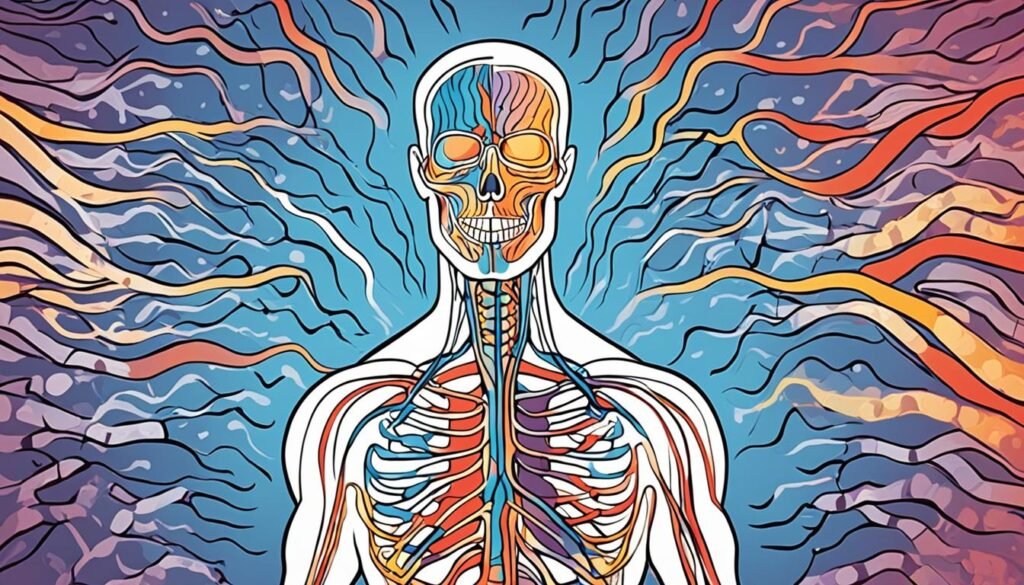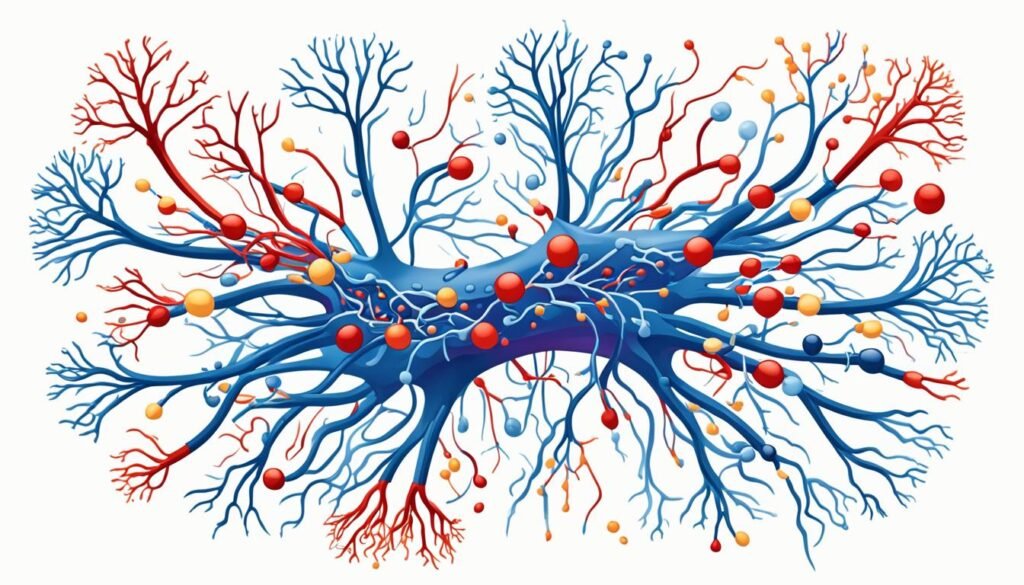Lambert-Eaton myasthenic syndrome (LEMS) is a rare problem that affects how nerves and muscles talk. This leads to muscle weakness and being tired. It can be linked with small cell lung cancer or happen on its own. Its symptoms range from trouble with walking to eyelids that droop. It also causes dry mouth, and problems with swallowing and breathing.
Doctors diagnose LEMS through exams, blood tests, and special tests like electromyography. They might also use imaging. Treatment works on handling any cancer that’s present. It also includes drugs to help nerve and muscle communication. Plus, you might get therapies to calm down your immune system.
Table of Contents
ToggleWhat is Lambert Eaton Myasthenic Syndrome?
Lambert Eaton Myasthenic Syndrome (LEMS) is an uncommon disorder. It affects how nerves and muscles talk to each other. Your immune system mistakenly fights the spots where they connect, leading to muscle weakness and tiredness.
Rare Autoimmune Disorder
LEMS is rare, only affecting about 2.8 million people across the globe. In the U.S., around 400 individuals have it. It’s an autoimmune issue. This means your body attacks the nerves and muscles by mistake.
Affects Neuromuscular Junctions
Neuromuscular junctions are key for nerve and muscle communication. LEMS messes up this connection. It stops nerves from telling muscles what to do correctly.
Causes Muscle Weakness
When communication breaks down, muscle weakness and tiredness set in. This is felt mostly in the legs, arms, neck, and face. So, simple tasks like walking or going up stairs become tough.

Causes of Lambert Eaton Myasthenic Syndrome
Lambert Eaton myasthenic syndrome (LEMS) is complicated, with many possible causes. It’s mainly tied to small cell lung cancer. But, it can happen on its own without a known cancer.
Associated with Small Cell Lung Cancer
Around 50 to 60 percent of LEMS cases are connected to small cell lung cancer. This type of cancer is the top cause for the paraneoplastic form of LEMS. People with this connection are usually middle-aged. They’ve smoked for a long time.
Autoimmune Response to Cancer
If LEMS is linked to small cell lung cancer, something interesting happens. The body fights the cancer in an autoimmune way. But, it also harms the neuromuscular junctions, causing muscle weakness. Sometimes LEMS shows up well before the cancer is found.
Other Underlying Autoimmune Diseases
For the other 40 to 50 percent of cases, LEMS happens without known cancer. Here, LEMS could be due to other autoimmune issues, possibly genetic. It shows up, on average, around 35 years old in these non-cancer cases.

Symptoms of Lambert Eaton Myasthenic Syndrome
The main signs of Lambert Eaton myasthenic syndrome (LEMS) are muscle weakness and tiredness, mainly in the legs. This makes walking or going up stairs hard for LEMS patients. They might also have drooping eyelids, a dry mouth, and find it hard to swallow or breathe.
Muscle Weakness and Fatigue
Muscle weakness and tiredness, especially in the legs, are key symptoms of LEMS. Simple tasks like walking or climbing stairs can be tough. However, the weakness can get a bit better right after you work out, which is unique to LEMS.
Difficulty Walking and Climbing Stairs
If you have LEMS, your legs might feel very heavy, and you could get tired fast. This will affect your ability to walk or climb stairs. It can really limit how much you can move around on your own.
Eyelid Drooping and Dry Mouth
Lid drooping and a dry mouth are also signs of LEMS. Droopy eyelids can mess with your vision. And a dry mouth can make it hard to swallow and cause discomfort.
Trouble Swallowing and Breathing
Some LEMS patients have trouble swallowing or breathing because their muscles don’t work right. Breathing might feel like it’s hard, and you could feel like you’re choking. These issues are serious and need quick attention.
Diagnosing Lambert Eaton Myasthenic Syndrome
Diagnosing Lambert Eaton Myasthenic Syndrome involves many steps. Your doctor will look at your symptoms and health history. They’ll do special tests to get a clear diagnosis.
Physical Examination and Medical History
Your healthcare provider will check your body. They will test your muscle strength and reflexes. They’ll also ask about your health to look for signs of LEMS.
Blood Tests for Antibodies
A key test for LEMS is checking for specific antibodies in your blood. Most LEMS patients have these anti-VGCC antibodies. These tests help confirm the disease’s autoimmune nature.
Electromyography (EMG) Test
The EMG test is crucial for diagnosing LEMS. It looks at the electric activity in your muscles and nerves. This gives insights into the disease’s specific muscle and nerve problems.
Imaging Tests for Underlying Cancer
LEMS may signal small-cell lung cancer. Imaging tests like CT and PET scans can find tumors. If no cancer shows up at first, you might need regular checks because LEMS can show up before cancer by a few years.
Treating Lambert Eaton Myasthenic Syndrome
The main goals of treating Lambert Eaton myasthenic syndrome (LEMS) are to manage any underlying cancer and boost nerve-muscle messages. If small cell lung cancer is found, treating it can greatly help with LEMS symptoms.
Medication to Improve Neuromuscular Signaling
Doctors may use drugs like 3,4-diaminopyridine (Firdapse) and pyridostigmine (Mestinon) to better nerve-muscle connections. These medicines aid in stronger muscle function by improving how nerve signals travel to muscles.
Immunosuppressants
Some patients might get immunosuppressants, which include steroids, azathioprine, and methotrexate. These drugs aim to reduce the autoimmune reaction that causes LEMS. Yet, they do have side effects and might raise the chance of getting infections or cancer.
Plasmapheresis and Immunoglobulin Therapy
For severe LEMS, plasmapheresis (blood filtering) or intravenous immunoglobulin (IVIG) therapy can be crucial. IVIG is usually preferred. It works by stopping harmful antibodies from attaching and possibly reducing the immune system products that harm nerve-muscle connections.
Lambert Eaton Myasthenic Syndrome and Cancer
Lambert Eaton Myasthenic Syndrome (LEMS) often links to a specific type of lung cancer. It shows up in about 60% of cases. This rare disease connects with small cell lung cancer (SCLC), which is known for causing the neuromuscular disorder.
Small Cell Lung Cancer
LEMS is well-known to be tied to SCLC. Research has found that most LEMS patients also have this type of cancer. Sometimes, LEMS shows up first, hinting at an undiscovered SCLC. This shows how essential it is for LEMS patients to get regular cancer checks.
Other Associated Cancers
Besides SCLC, LEMS has been linked to other cancers like prostate cancer and thymoma. These cancers are not as common but are still found in some LEMS patients. Hence, regular and thorough cancer screenings are important for anyone with LEMS.
Regular Screenings for Underlying Cancer
LEMS and cancer, mainly SCLC, go hand in hand. Thus, constant cancer checks are a must for those with LEMS. Even if cancer is not found when LEMS is diagnosed, consistent checks are still necessary. This helps in catching cancer early, which can greatly help LEMS patients.
Living with Lambert Eaton Myasthenic Syndrome
Dealing with challenges from Lambert Eaton myasthenic syndrome (LEMS) needs a smart daily approach. A big part is staying away from what makes muscle weakness worse, like heat and fever.
Avoiding Triggers Like Heat and Fever
LEMS gets worse with high body heat. So, think about what you do to avoid getting too hot. Don’t take hot baths or showers. If you feel sick or have a fever, see a doctor. Illnesses can make muscle weakness a lot worse.
Exercise and Sleep Management
Keeping active with moderate exercise and enough sleep can help a lot. Make sure not to push yourself too hard. Talk to your doctor about the best exercise plan for you.
Support Resources
Joining groups with others who have LEMS can give you both emotional and practical support. Look for support groups online or in your area. They can help you share stories, learn how to cope, and get updates on LEMS.
Although there’s no cure for LEMS, managing it well and leaning on a supportive community can improve life quality.
The Rarity of Lambert Eaton Myasthenic Syndrome
Lambert-Eaton Myasthenic Syndrome (LEMS) is a very rare autoimmune disorder. Only about 2.8 people out of a million have it worldwide. In the United States, around 400 people are known to have this tough condition. The fact that LEMS is so rare shows why we need more knowledge, research, and special care for its patients.
Worldwide Prevalence
LEMS affects very few people, with only 2.8 million cases across the globe. This number is 46 times fewer than myasthenia gravis, another condition. Because LEMS is so uncommon, it’s important we make sure more doctors and the public know about it.
Incidence in the United States
In the United States, just about 400 people have been diagnosed with LEMS. This small number highlights how rare the disorder is. It also points to the difficulties these patients face in getting the right medical help and support. We must keep working to make people aware of LEMS and improve access to its specialized care.
Conclusion
Lambert Eaton Myasthenic Syndrome is a rare disorder. It affects the way nerves and muscles communicate, causing severe muscle weakness. Small cell lung cancer is often linked to this condition, but it can happen without cancer too.
People with LEMS need proper diagnosis and care. This includes treating any cancer and using therapies to better nerve-muscle signaling and lower the immune system’s attack. Taking these steps is key for those with LEMS.
Learning about LEMS and its effects helps doctors and patients. They can team up to find the best ways to fight the symptoms and pain. It’s important to remember that LEMS is not common, so raising awareness and doing more research is crucial. This can lead to better care for those living with LEMS.
By pushing forward with research, we can find new ways to treat LEMS. This will help doctors offer more effective support and hope to patients with this challenging condition.
FAQ
What is Lambert Eaton Myasthenic Syndrome?
Lambert Eaton Myasthenic Syndrome (LEMS) is a rare condition affecting nerve-to-muscle communication. It causes muscle weakness and fatigue.
What causes Lambert Eaton Myasthenic Syndrome?
LEMS is tied to small cell lung cancer in about 60% of cases. This connection is due to the immune system fighting both the cancer and the neuromuscular junctions. Sometimes, it occurs without cancer, possibly related to other autoimmune diseases.
What are the symptoms of Lambert Eaton Myasthenic Syndrome?
Main symptoms include muscle weakness and fatigue, mostly in the legs. This can lead to problems with walking or stair climbing. Other signs are drooping eyelids, dry mouth, swallowing trouble, and difficulty in breathing.
How is Lambert Eaton Myasthenic Syndrome diagnosed?
Diagnosis includes a physical exam and looking at your health history. Blood tests check for specific antibodies. An EMG test checks neuromuscular function. Doctors might also use imaging tests to look for cancer.
How is Lambert Eaton Myasthenic Syndrome treated?
Treatment aims to manage any cancer and enhance nerve-to-muscle signal. Doctors may use drugs such as 3,4-diaminopyridine and pyridostigmine. Also, immunosuppressants to reduce autoimmune response. Plasmapheresis or immunoglobulin therapy might be options in severe cases.
Is there a link between Lambert Eaton Myasthenic Syndrome and cancer?
Yes, LEMS is often linked with small cell lung cancer. But prostate cancer, thymoma, and lymphoproliferative diseases have connections too. Regular cancer screening is vital for LEMS patients.
How can individuals with Lambert Eaton Myasthenic Syndrome manage their condition?
To cope daily, avoid heat and fever, exercise regularly, and get plenty of rest. Joining support groups can also help. It’s essential to watch for cancer development.
How rare is Lambert Eaton Myasthenic Syndrome?
LEMS is very uncommon, affecting around 2.8 million people globally. In the U.S., it affects about 400 people. Such rarity highlights the need for more awareness, research, and specialized care.
Source Links
- https://www.hopkinsmedicine.org/health/conditions-and-diseases/lamberteaton-syndrome
- https://www.mda.org/disease/lambert-eaton-myasthenic-syndrome
- https://www.nhs.uk/conditions/lambert-eaton-myasthenic-syndrome/
- https://www.ncbi.nlm.nih.gov/books/NBK507891/
- https://www.mda.org/disease/lambert-eaton-myasthenic-syndrome/medical-management
- https://rarediseases.org/rare-diseases/lambert-eaton-myasthenic-syndrome/
- https://www.ncbi.nlm.nih.gov/pmc/articles/PMC4928366/
- https://www.ncbi.nlm.nih.gov/pmc/articles/PMC6690495/
About The Author

This article is medically reviewed by Dr. Chandril Chugh, Board-Certified Neurologist, providing expert insights and reliable health information.
Dr. Chandril Chugh is a U.S.-trained neurologist with over a decade of experience. Known for his compassionate care, he specializes in treating neurological conditions such as migraines, epilepsy, and Parkinson’s disease. Dr. Chugh is highly regarded for his patient-centered approach and dedication to providing personalized care.
→ Book a consultation to discover which remedies suit your needs best.




